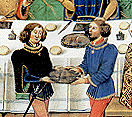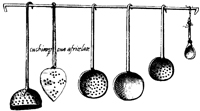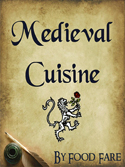|
Special Edition: Medieval Cuisine May 2013 Volume 13, Issue #2
CAUDEL (spiced beer; also known as Buttered Beere)
Place egg yolk in a saucepan; slowly whisk in the beer. Add the sugar and spices; heat over medium-high heat until mixture just comes to a boil. Remove from heat. Add butter, and whisk until well-mixed. Serve hot.
HEDGEHOGS (Meat Pudding with Almonds)
In a large bowl, combine the ground beef, breadcrumbs, spices, seasonings and softened butter. Bind with beaten egg yolks. Using hands, form beef into a ball. Place beef ball in a buttered cooking pot or large frying pan. Cook covered for about one hour, basting with remaining 4 TBS butter melted into 4 TBS water. Stick slivered almonds all over the pudding so that the ball resembles a hedgehog. Serve.
POKEROUNCE (Bread & Honey with Pine Nuts)
Place the honey in a saucepan, and then add the spices. Stir over low heat until the honey and spices are well-blended. Be careful not to let the honey burn. Cool the mixture, and then toast individual slices of bread (bread quantity will depend on how much of the honey mix you dollop on each slice). Cut the slices of bread into quarters (either square or lengthwise), and lay them flat on a plate or cookie sheet. Drizzle the honey mixture over the toast pieces, and then place the pine nut kernels upright into the bread so they are erect. Make patterns with the pine nuts, or eat the toast as is.
Food Fare receives e-mail from reader's who have something to say about our web site, recipes, cookbooks, food articles and e-books in the Culinary Collection.
Are you an epicurean who fancies food-related computer diversions? Check our links to foody games which can be downloaded and played at home or online.
|
It's no secret Medieval Cuisine is the most popular title in the Culinary Collection. Since debuting at Amazon and Barnes & Noble in July 2011, the book has consistently sold copies numbering in the triple - and sometimes quadruple - digits every month.
With the book's popularity also came an influx of messages and general comments from readers. Eventually, I added an individual Reader's Mail page for all remarks and questions relating to Medieval Cuisine, and last year established a page displaying reviews about the title. Not all of the reviews were good, of course, but that's the nature of the business. Not everyone is going to like the writing style or graphics, although for the most part feedback has been positive.
The most recurring complaint was about the quantity of recipes included in the book. The original edition of Medieval Cuisine (released in 2011) contained eleven recipes. Additionally, the same recipes were made freely available on the Food Fare web site for all to enjoy.
Earlier this year, I dug into my old research notes about medieval food and culture, when I chose several new recipes to add to the existing book. The endeavor also led me to add new content. To that end, Medieval Cuisine has been re-released with fifteen extra dishes. The new edition now has a total of twenty-six recipes.
This special edition of Food Notes provides snippets from the book, along with mention of the news recipes and random remarks by readers who have enjoyed the title so far.
Food in the Middle Ages was not necessarily crude and inedible. It was certainly lacking by today's standards, but was not as distasteful as one might think.
Class differences created a wide gap in food consumption. The wealthier class consumed more meat dishes, fish and breads. Their food was often prepared with herbs and spices. On the other hand, a common peasant meal consisted of bread made from rye, a small portion of meat, few vegetables and perhaps some cheese. Special occasions called for rabbit or poultry.
Vegetables were a common part of the medieval diet, but were not a focal part of the feast menu as they were considered a secondary item. Typical vegetables grown were asparagus, beets, Brussels sprouts, cauliflower, celery, chard, cress, mushrooms, parsnips, pumpkin, radishes, olives, cabbage, onions, leeks, carrots, garlic, peas, beans, squash, melons and cucumbers. Onions were considered "peasant" fare, and dismissed by the upper classes. Additionally, it was believed onions were bad for the complexion and created "ill-humor" in people. Typical methods of preparing vegetables included boiling in water with butter, olive oil and salt; or boiled and then mashed, mixing with other ingredients to make pie fillings and stuffing. Text excerpt from Medieval Cuisine (c)2013 Food Fare; reprinted with permission.
Spits were common tools used in cooking. Positioned over open fires, the long metal sticks were rotated manually to cook food evenly, such as meat or whole animals. Adjustable hooks also hung over the fire. Cauldrons were attached to the hooks, where temperatures could be controlled by removing the cauldron from the heat. Other cooking equipment included kettles, which were considered all-purpose tools for boiling water and food such as meats, vegetables and soups.
Utensils were indicative of social status. Quantity and quality of plate was a clue to the wealth of an individual, as was the content from which it was made. Plates were created from silver gilt, plain silver or gold. Tankards were of quality design as well, and often became collectibles in noble families. Spice plates were shallow, with wide bowls on stems used for serving a wide range of foods from meat to fruit. Pewter also became popular in the Dark Ages, when it was used in dishes, platters, saucers and tankards. Pottery was another favored type of eating ware. The salt cellar was placed on every table in several places at a feast, which was merely a small bowl filled with salt. It was also part of the social division, referring to those who sat "above" or "below" the salt in the dining pecking order. Text excerpt from Medieval Cuisine (c)2013 Food Fare; reprinted with permission.
Read reviews about Medieval Cuisine . . .
We're working on our next Culinary Collection installment, scheduled for release near the end of the year. Keep your eyes peeled...
Check for updates on our News page and Appetizing Muse, or visit us at Facebook, Google+, Pinterest and Twitter.
Happy Cooking from Food Fare, |
Shenanchie O'Toole Chief Editor, Food Notes
Connect with Shenanchie: Appetizing Muse (blog)
CREMONEZE (Spinach Tart)
Mix all ingredients together in a large bowl. Form mixture into a single crust on a greased baking sheet. Bake at 350-degrees F for about forty-five minutes, or until lightly golden. Allow to cool before cutting into squares. Serve.
CRUSTE ROLLE (Fried Crackers)
Measure flour into a bowl; make a well in the center of the flour. In another bowl, beat together the eggs, saffron and salt; pour mixture into flour well. Mix thoroughly. If dough appears too moist or dry, add additional flour or water as needed. Separate dough into pieces about 1/2" in diameter. Roll pieces thinly, or until they measure two or three inches in diameter. Fry in vegetable oil until golden brown, turning once. Serve hot.
FYGEY (Fig & Almond Pudding)
In a saucepan, mix ground almonds with some of the wine and water to form a paste. Add remaining wine; allow mixture to steep over medium heat for about five minutes. Add figs, raisins, honey, ginger and salt to the mixture and cook for another five minutes or until thickened. Serve.
GRONDEN BENES (Ground Beans Stew)
Soak the dried beans in water overnight. Next day, drain the beans and place in a large cooking pot with the broth. Bring to the boil; simmer for about one hour or until beans are nearly soft, stirring frequently. Cook the bacon cubes or pieces in a frying pan until fully cooked; set aside on paper towels to drain excess fat. Continue simmering beans and stock for another ten to fifteen minutes. Using a potato masher or large fork, roughly mash beans while in broth. Add the bacon cubes or pieces and black pepper; simmer and stir for another ten minutes. Serve hot. Garnish individual servings with parsley, if desired. Please Note: Salt is not necessary for this dish as it is already contained in both the broth and bacon.
|


 Food in medieval times was prepared using few methods. Soups were
common, into which anything could be thrown in from pork to berries
or mint, creating an almost porridge-like texture. Presentation was
not as important then as it now. Many ingredients used in the dark
ages are also not available today. One typical
meal was pigeon cooked in an oyster shell. While just an example, it
emphasizes the difference between eating aesthetically-pleasing
food, and eating to survive.
Food in medieval times was prepared using few methods. Soups were
common, into which anything could be thrown in from pork to berries
or mint, creating an almost porridge-like texture. Presentation was
not as important then as it now. Many ingredients used in the dark
ages are also not available today. One typical
meal was pigeon cooked in an oyster shell. While just an example, it
emphasizes the difference between eating aesthetically-pleasing
food, and eating to survive. Bread in medieval times was of surprising good quality. It was known
as "paindemaigne" or "manchet." The better quality of bread was
served to the upper class, while people in a "lower status" ate
bread which was coarse and of darker color, called "tourte" or "trete."
However, both classes of bread were made into round loaves and
marked with a cross. Bread-making was strictly regulated in the
Middle Ages, when Bakers Guilds were formed. Laws were imposed
whereby bread was measured by weight and pricing. There were also
health issues to consider, which was governed by laws for quality
and freshness.
Bread in medieval times was of surprising good quality. It was known
as "paindemaigne" or "manchet." The better quality of bread was
served to the upper class, while people in a "lower status" ate
bread which was coarse and of darker color, called "tourte" or "trete."
However, both classes of bread were made into round loaves and
marked with a cross. Bread-making was strictly regulated in the
Middle Ages, when Bakers Guilds were formed. Laws were imposed
whereby bread was measured by weight and pricing. There were also
health issues to consider, which was governed by laws for quality
and freshness. Medieval ovens were typically built from stone, where open fires
burned. Burying food in hot ashes was another method used to cook or
heat food. Kitchens in the Middle Ages varied according to
individual income and lifestyle. Fuel was expensive, so most of the
cooking took place over a fire in the main room of the house rather
than a separate kitchen area. The fire was usually fueled by wood,
although other combustibles were also used: peat, straw or furze.
Coal was another option, but expense often prohibited its use.
Medieval ovens were typically built from stone, where open fires
burned. Burying food in hot ashes was another method used to cook or
heat food. Kitchens in the Middle Ages varied according to
individual income and lifestyle. Fuel was expensive, so most of the
cooking took place over a fire in the main room of the house rather
than a separate kitchen area. The fire was usually fueled by wood,
although other combustibles were also used: peat, straw or furze.
Coal was another option, but expense often prohibited its use. A typical list of tools and equipment used in a medieval kitchen
might be an amphora (two-handled wine vessel); aumbry
(a multi-tiered cabinet for display of crockery, and the final
preparation area of food before it was served); beaker (a
large drinking vessel with a wide mouth, made of glass and without
handles); botijos (a common kitchen jug where staples were
kept, such as oil); cantir (a pouring vessel similar to a
pitcher or flagon for drinks such as wine, ale or cider); charger
(a large serving platter designed with gold, silver and copper and
embossed with engravings); cholent pot (heavy metal stewing
pot); ecuelle (porridge bowl); faience (tin-glazed
earthenware); flagon (a jug or pitcher); flask (storing or
pouring vessel); and a pele (a long-handled paddle for
placing and removing bread, pies and pastries from ovens).
A typical list of tools and equipment used in a medieval kitchen
might be an amphora (two-handled wine vessel); aumbry
(a multi-tiered cabinet for display of crockery, and the final
preparation area of food before it was served); beaker (a
large drinking vessel with a wide mouth, made of glass and without
handles); botijos (a common kitchen jug where staples were
kept, such as oil); cantir (a pouring vessel similar to a
pitcher or flagon for drinks such as wine, ale or cider); charger
(a large serving platter designed with gold, silver and copper and
embossed with engravings); cholent pot (heavy metal stewing
pot); ecuelle (porridge bowl); faience (tin-glazed
earthenware); flagon (a jug or pitcher); flask (storing or
pouring vessel); and a pele (a long-handled paddle for
placing and removing bread, pies and pastries from ovens).








